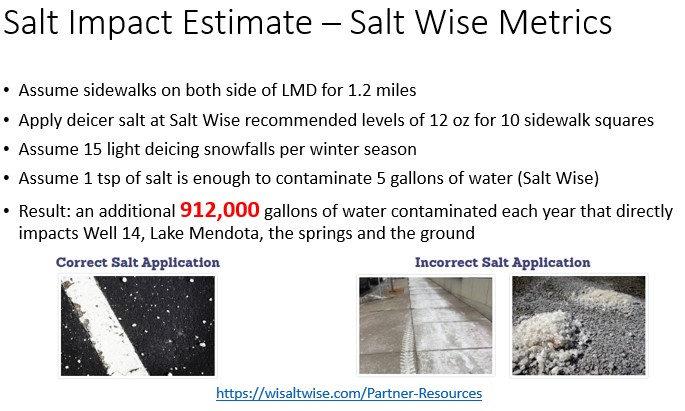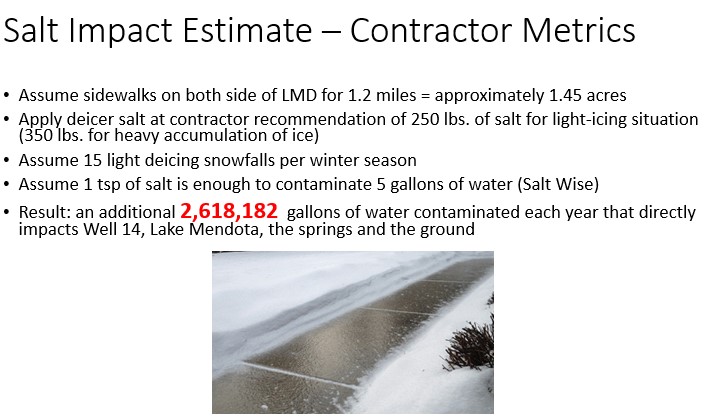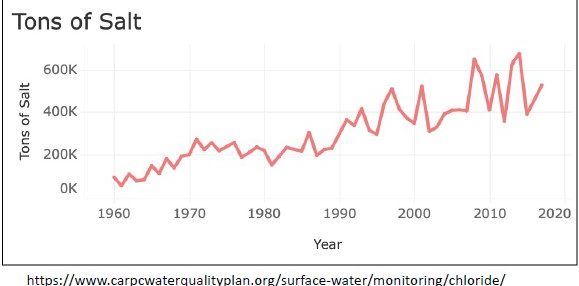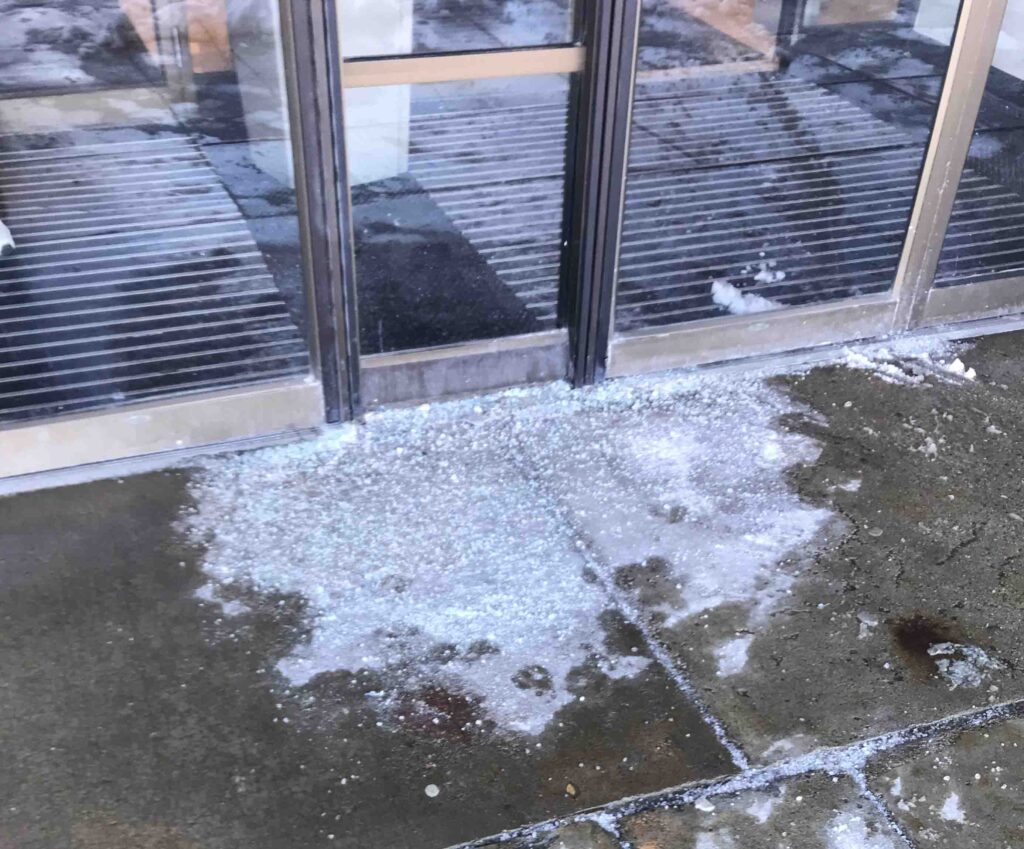Salt
Salt (NaCL) is contaminating the water in Lake Mendota, Well 14 and the springs and doing environmental damage at an alarming rate.
How did we get here?
At one time salt was considered a rare and valuable commodity. It served as a currency, influenced the location of trade routes and cities, started wars and taxes on it financed governments. It was stockpiled by merchants in their basements and not wasted. Not until the 20th century did modern geology discover that it is available in quantities that make it quite common. (Salt, A World History, Mark Kurlansky)
Since the 1940’s it has been used to deice roads, sidewalks and parking lots and as those impervious surfaces have increased in volume and people have expected ice free conditions at all times, the amount of salt applied has risen exponentially. In the 50 years after the 1940’s the amount of road salt sales increased from .14 to over 18 million metric tons per year. Most of NaCl used on roads each year is applied in northeastern and midwestern states, with six states using three quarters of the total: New York, Ohio, Michigan, Illinois, Pennsylvania, and Wisconsin. https://www.pnas.org/doi/full/10.1073/pnas.0507389102
The Impact
The result of all this salt being spread on impervious surfaces is that freshwater lakes, rivers, and groundwater resources are becoming saltier. Salt does not go away. It runs off and leaches into freshwater systems. As the salinity of freshwater reaches elevated levels many freshwater organisms will be unable to survive in that waterbody. On the other hand, invasive species that like brackish water may flourish and take over the water ecosystem.
Road salt can also be detrimental to lakes in other ways. Water polluted by road salt is denser than freshwater and therefore salt contaminated water will settle to the deepest part of the lake where it can accumulate. This chemical stratification, or the development of layers of water due to density differences, can prevent the natural mixing of lakes, which in turn can lead to a near permanent layer in the lake’s bottom waters. Often that bottom layer becomes devoid of oxygen and is unable to support aquatic insects and fish life.
Chloride, which makes up about 60 percent of road salt, is a detrimental pollutant in excess quantities. Elevated amounts of chloride are toxic to fish, aquatic plants, aquatic insects, amphibians, zooplankton and algae.
As concerning the indication of NaCl in freshwater is really a reflection of pollution in the surrounding landscape so the concerns are not just on the water but the entire ecosystem.
Measuring the Impact of the Lake Mendota Drive Reconstruction Project
The Lake Mendota Drive reconstruction project contemplates the addition of sidewalks which will result in salt being applied to them during winter months. Below are two calculations that estimate the amount of salt that will be applied and how much water will be contaminated as a result.
Calculation 1: Using Metrics from Salt Wise
More Sidewalks & More Salt Pollution are Linked
As more sidewalks are poured on Lake Mendota Drive and further up in the watershed, homeowners and contractors will use salt to deice this new hardscape.
This is an increase in salt usage which will further pollute Well 14. Even if the City reduces road hardscape to accommodate sidewalk hardscape it will likely be a net increase in salt usage because the City has adopted a policy of only using salt on main roads where it is probable that sidewalks exist. But on side streets that are not salted, an introduction of sidewalks will introduce new salt usage. This results in more salt working its way into Well 14, Lake Mendota and the Springs.

Calculation 2: Using Metrics from Contractor Recommendations
Contractors are more aggressive about keeping driveways and sidewalks free of ice for liability reasons and that is what homeowners and businesses require.
They apply salt in aggressive quantities to also prevent them having to make return visits to the area which costs them money and creates more wear and tear on equipment.
Using contractor metrics to calculate environmental damage shows much higher water contamination results.

Salt Usage Increasing
Impervious surfaces in road, sidewalks, parking lots and driveways have been increasing every decade and salt use has been increasing as well.
Statistics on salt usage on Dane County roads show a steady increase every decade. This salt use during winter months is what is increasing the sodium concentration levels in Well 14, the springs and Lake Mendota.
Salt usage has increased 3-fold since 1990 on Dane County trunk roads.
Salt use on parking lots, sidewalks and driveways is not tracked but is assumed to be roughly tracking the road use and adds to the salination of water sources like Well 14.
Usage is highly variable from year to year but on an upward trend.

Where is salt in Madison being applied?
Everywhere there are hard surfaces that people walk or drive on. Commercial contractors are heavy users as they are specifically hired to make sure people don’t slip and fall. County and city workers apply a lot of salt especially in busy traffic areas and where people walk.
The picture shows a heavy application of salt at a West Towne Mall store that will eventually make its way into Lake Mendota. The picture was taken in February 2023.
